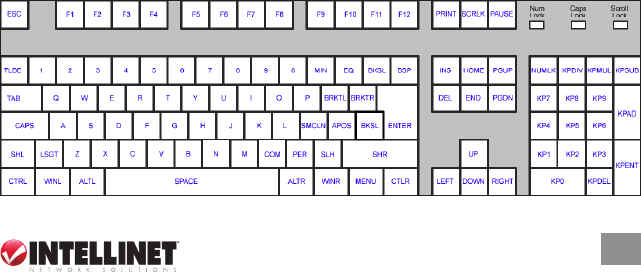
Server Name for Viewers
Enter the server name you chose for the video server on the switch, and it will appear on the
title bar of your switch’s viewer window.
Keyboard Layout
Choose the keyboard layout for the switch according to the real keyboard you’re using on the
remote login client. Choosing the correct keyboard layout for your keyboard is very important
since some key codes are represented by different keys, depending on the keyboard layout.
Also, a correct keyboard layout setting ensures that you’ll have a key code output on the server
side that matches what you’ve input on the physical keyboard from the client computer side.
The default keyboard layout is the U.S. keyboard, though the switch supports more than 60
types of keyboards used all over the world.
Largest Possible Screen
The switch supports a maximum resolution of up to 1600 x 1200 pixels. Normally, the greatest
resolution support (1600 x 1200) will be the setting that is most accommodating to all display
resolution requirements. However, you can still select a smaller workable resolution for your
display device. If you choose a smaller resolution, be aware that any screen larger than what
you specify here will not be shown on the viewer. The switch supports the following resolutions:
• 640 x 400 • 640 x 480 • 800 x 600 • 1024 x 768 • 1152 x 864 • 1280 x 1024 • 1600 x 1200
(For details about the refresh rate support, go to the Video Mode Database section.)
Hot Keys
The Digital KVM over IP Switch can detect a special sequence of keystrokes when you type on
your remote keyboard. This special sequence is used to ask the switch to resynchronize the
local and remote mouse cursors in a fast and convenient way. For example, it is faster to type
CTLR–CTLR–Home on the keyboard than to use the mouse and select a command in a menu.
For compatibility with higher devices, this command is divided in two parts: viewer hot keys
and a mouse resynchronization key.
The viewer hot keys are transmitted to the switch or server attached to the switch, whereas the
mouse resynchronization key is ltered out by the switch. Thus, because the viewer hot keys
are transmitted, they must be as harmless as possible. Viewer hot keys such as NumLock-
NumLock, Scrlk-Scrlk or Ctrl-Ctrl can work because they produce, generally, no effect. On the
other hand, the mouse resynchronization key can be anything since it is not transmitted by
TKIP-101.
Hot keys can be congured to t your needs, as well, based on the key positions on a standard
keyboard, as shown below. NOTE 1: The viewer hot keys are transmitted to the switch that’s
attached, thus they must be chosen so that they don’t interfere with the switch’s hot keys.
NOTE 2: If you’re running the Java viewer on Mac OS, you may nd that the default mouse
resynchronization sequence — CTLR–CTLR–Home — doesn’t work. This is because the
Right Control key on a Mac keyboard sends out a different key code than a PC keyboard does.
If this is the case, consider conguring your hot keys differently (CTLL-CTLL and S, as an
example).
41
MANAGEMENT OVER A BROWSER


















